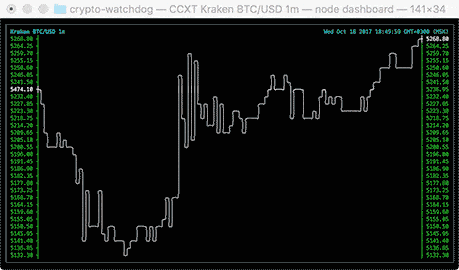@tudorelu hey! ) You might want to check this issue: https://github.com/kroitor/asciichart/issues/39
Basically, that gif is compiled of screenshots taken once every minute on a redrawing chart. Automating those screenshots is an OS-specific task, but should not be a problem. The chart series has to be kept constant in length, since that defines the width of the graph. When the underlying exchange has a new fresh candle, the most recent candles are redrawn, then a screenshot is taken. Then I leave it working for a few hours, it generates a number of screenshots, one every minute. Then i compile them into a gif and speed them up a thousand times to make it "look fast". Check the timestamp in the upper right corner of the gif – it is not in real-time. In other words, that gif runs 1000x the real speed of OHLCV updates from the exchanges.
If you redraw it in real-time from 1m-OHLCV candles, then your FPS is 1/60 (one frame per minute), which is very slow – you won't see any "smooth animation". Therefore, in reality, an OHLCV chart is a low-fps chart. You may want to pick a different source of data (like the current tip of the orderbook), that will indeed update very frequently, so you may even want to manually limit the upper boundary on fps to avoid eating too much cpu for redrawing the frames.
Let me know if the above explanation does not help.

Hi man,
This is an awesome lib! I'm wondering if you could give some hints as to how you made the live-updating example work (looking to do it in python).